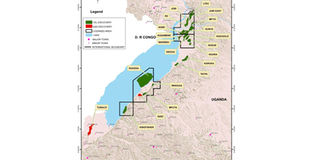Prime
Journey to FID: History of petroleum exploration

What you need to know:
- Last week, government and joint venture partners signed the Final Investment Decisions (FDI). This has been a long journey that dates as far back as 1925 when a government geologist E.J. Wayland first documented Uganda’s petroleum potential in a publication Petroleum in Uganda. In this article, first published by Petroleum Authority of Uganda, we take you through some key dates.
The petroleum potential of Uganda was first documented in 1925 by a government geologist E.J. Wayland, in the publication Petroleum in Uganda.
The report documented existence of oil seepages along the shores of Lake Albert on both Uganda and DR Cong sides.
1936 -1956
During this period, the first shallow stratigraphic wells were drilled by the African - European Investment Company. The first deep well, Waki B-1 was drilled in Butiaba, in 1938 and encountered bitumen.
Twenty shallow wells were drilled in Kibiro and Kibuku areas for geological correlation and these are documented by Harris et al 1956.
The Geological surveys and Mines Department, during the 1940’s and 50’s established the presence of sedimentary sequences in the Albertine Graben (Memoirs of the Geological Survey, 1959).
1945 - 1980
This period is referred to as the period of Limited Activity because of the Second World War, change in policies of colonial masters where East Africa was zoned for agriculture coupled with post-independence political uncertainties and instability in the country.
1983
It is in this year that consistent and modern efforts commenced with the acquisition of 9,578-line km of aeromagnetic data that identified three depo centres along the entire length of the Graben and have been going on.
FID and first oil
President Museveni last week witnessed the announcement of the Final Investment Decision for Uganda’s oil and gas projects by TotalEnergies, CNOOC, Uganda National Oil Company and Tanzania Petroleum Development Corporation. The ceremony, which took place at the Kololo, Kampala was also attended by Vice President of the Tanzania Phillip Isdor Mpango. The President alleyed fears about Uganda’s oil project that it will not progress due to the energy transition.
Key dates
1985: Petroleum (Exploration and Production) Act is enacted
World Bank credit to support to Petroleum Exploration Promotion
1986: Commencement of specialised training in petroleum aspects
1990: Cooperation Agreement between Uganda and DR Congo for Joint Exploration and Development of Common fields signed
1991: A PSA between Fina Exploration Uganda and government is signed. Fina takes the entire Albertine Graben. Formation of Petroleum Exploration and Production Department; PEPD carried out ground geological and geophysical surveys in areas identified by the aeromagnetic data. Data acquired was used to promote the Albertine Graben for investment
1993: Petroleum (Exploration and Production) (Conduct of Exploration Operations) Regulations, 1993 came into force.
1997: Licensing of Exploration Area 3 (Semliki Basin), to Heritage Oil and Gas Limited (Heritage)
1998: Heritage acquires the first 2-D seismic data (170-line kilometers) in Uganda.
2001: Hardman Resources and Energy Africa is licensed Exploration Area 2 (Northern Lake Albert Basin)
2002 – 2004: Drilling of Turaco wells by Heritage and Energy Africa, the first deep wells in the basin to encounter oil and gas.
Heritage is licensed to exploration Area 1 (Pakwach basin).
Other key activities over time in the oil and gas sector
2005
Exploration Area 5 (The Rhino Camp Basin) is licensed to Neptune Petroleum (Tower Resources).
Drilling of Mputa-1 well by Hardman and Energy Africa in Kaiso-Tonya area.
2006
Hardman Petroleum Pty (now Tullow) makes the first commercial discovery well in Kayiso Tonya area.
Hardman Petroleum Pty (now Tullow) signs a Memorandum of Uganda with government for an Early Production Scheme (EPS) for oil production, Seniorping plant; and Thermal Power generation - 50-85MW.
2007
Dominion Petroleum is licensed to Exploration Area 4B.
2008
Cabinet approves the National Oil and Gas Policy;
2010 – 2012
Farm-out of Heritage Oil and Gas to Tullow and Farm-in of Total E & P Uganda and CNOOC Uganda Limited
Production License over Kingfisher issued
2013
Petroleum (Exploration, Development and Production) Act 2013 enacted
In addition to Kingfisher, Total and Tullow submit applications for possible award of Production Licenses over sixteen (16) discoveries
2014
A Memorandum of Understanding on commercialisation was signed between government of Uganda and licensed oil companies, which under pinned the three principle options of crude for export, refinery and crude for power, among others.
2015
Appointment of the board of directors for the Petroleum Authority of Uganda is done.
Uganda had the first competitive licensing round for six blocks in the Albertine Graben, that culminated into the licencing of Armour Energy Limited (Australia) and Oranto Petroleum Limited (Nigeria)
2016
Six (6) Production Licenses issued to Tullow Uganda Operations Pty and three (3) Production licences issued to Total E & P Uganda
Appointment of Executive Director for the Petroleum Authority of Uganda
Seven sets of Upstream and Midstream Petroleum Regulation issued
The Hoima to Tanga Crude oil pipeline routing agreed
2017
Appointment of Directors for the Petroleum Authority of Uganda
Feed for Upstream Facilities and also for EACOP were launched
IGA for EACOP was signed between Uganda and Tanzania and foundation stone laid
New exploration licenses were issued to Armour Energy Limited (Australia) and Oranto Petroleum Limited (Nigeria).
This article this article first published by Petroleum Authority of Uganda.




